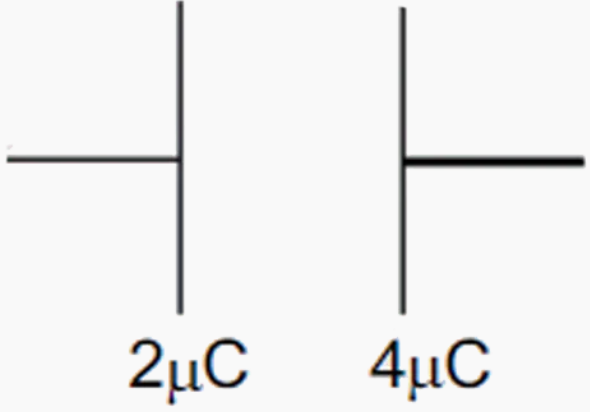Two capacitors of capacitance 2μF and 3μF are joined in series. Outer plate first capacitor is at 1000 volt and outer plate of second capacitor is earthed (grounded). Now the potential on inner plate of each capacitor will be
700 Volt
200 Volt
600 Volt
400 Volt
The correct Answer is:D
To solve the problem of finding the potential on the inner plates of two capacitors connected in series, we can follow these steps:
1. Identify the Capacitors and Their Capacitances:
- We have two capacitors:
- C1=2μF
- C2=3μF
2. Understand the Configuration:
- The outer plate of the first capacitor is at 1000V.
- The outer plate of the second capacitor is grounded (at 0V).
- The capacitors are connected in series.
3. Determine the Voltage Across Each Capacitor:
- Let V be the potential on the inner plate of the first capacitor (between C1 and C2).
- The voltage across the first capacitor C1 is given by:
VC1=1000V−V
- The voltage across the second capacitor C2 is:
VC2=V−0V=V
4. Use the Relationship of Charge in Series:
- In series, the charge Q on both capacitors is the same:
Q=C1⋅VC1=C2⋅VC2
5. Substitute the Values:
- For C1:
Q=2×10−6⋅(1000−V)
- For C2:
Q=3×10−6⋅V
6. Set the Equations Equal:
2×10−6(1000−V)=3×10−6V
7. Simplify the Equation:
- Cancel 10−6 from both sides:
2(1000−V)=3V
- Expanding gives:
2000−2V=3V
8. Combine Like Terms:
2000=5V
9. Solve for V:
V=20005=400V
10. Conclusion:
- The potential on the inner plate of the first capacitor is 400V.
- The potential on the inner plate of the second capacitor (which is the same as the inner plate of the first capacitor) is also 400V.
Final Answer:
- The potential on the inner plate of each capacitor is 400V.
- We have two capacitors:
- C1=2μF
- C2=3μF
- The outer plate of the first capacitor is at 1000V.
- The outer plate of the second capacitor is grounded (at 0V).
- The capacitors are connected in series.
- Let V be the potential on the inner plate of the first capacitor (between C1 and C2).
- The voltage across the first capacitor C1 is given by:
VC1=1000V−V
- The voltage across the second capacitor C2 is:
VC2=V−0V=V
- In series, the charge Q on both capacitors is the same:
Q=C1⋅VC1=C2⋅VC2
- For C1:
Q=2×10−6⋅(1000−V)
- For C2:
Q=3×10−6⋅V
2×10−6(1000−V)=3×10−6V
- Cancel 10−6 from both sides:
2(1000−V)=3V
- Expanding gives:
2000−2V=3V
2000=5V
V=20005=400V
- The potential on the inner plate of the first capacitor is 400V.
- The potential on the inner plate of the second capacitor (which is the same as the inner plate of the first capacitor) is also 400V.
- The potential on the inner plate of each capacitor is 400V.
Topper's Solved these Questions
- ELECTRIC POTENTIAL & CAPACITANCEBOOK - A2ZCHAPTER - ELECTRIC POTENTIAL & CAPACITANCEEXERCISE - Capacitor Circuits
52 Videos
- ELECTRIC POTENTIAL & CAPACITANCEBOOK - A2ZCHAPTER - ELECTRIC POTENTIAL & CAPACITANCEEXERCISE - Problems Based On Mixed Concepts
44 Videos
- ELECTRIC POTENTIAL & CAPACITANCEBOOK - A2ZCHAPTER - ELECTRIC POTENTIAL & CAPACITANCEEXERCISE - Capacitor With Dielectric
32 Videos
- ELECTRIC CHARGE, FIELD & FLUXBOOK - A2ZCHAPTER - ELECTRIC CHARGE, FIELD & FLUXEXERCISE - Section D - Chapter End Test
29 Videos
- ELECTROMAGNETIC INDUCTIONBOOK - A2ZCHAPTER - ELECTROMAGNETIC INDUCTIONEXERCISE - Section D - Chapter End Test
30 Videos
Similar Questions
Knowledge Check
Two capacitors of 2μF and 3μF are connected in series. The potential at point A is 1000 volt and the outer plate of 3μF capacitor is earthed. The potential at point B is
 A300 voltB500 voltC600 voltD400 volt
A300 voltB500 voltC600 voltD400 voltThe capacitor of capacitance 4μF and 6μF are connected in series. A potential difference of 500 volts applied to the outer plates of the two capacitor system. Then the charge on each capacitor is numerically
A6000CB1200CC1200μCD6000μCThree capacitors 2μF,3,μFand6μF are joined'in series with each other.
The equivalent capacitance is:A12μFB1μFC2μFD11μF
Two parallel plate capacitors of capacitances 2 μF and 3 μF are connected in series. Calculate the maximum voltage, for the combination if capacitor of capacitance 3μF can withstand a voltage of 6 kV and capacitor of capacitance 2μF can withstand a voltage of 7 kV.
View SolutionTwo capacitors of capacitances 10μFand20μF are connected in series across a potential difference of 100V. The potential difference across each capacitor is respectively
View SolutionTwo capacitors of capacitance 2μFand5μF are charged to a potential difference 100V and 50 V respectively and connected such that the positive plate of one capacitor is connected to the negative plate of the other capacitor after the switch is closed, the initial current in the circuit is 50 mA. the total resistance of the connecting wires is (in Ohm):
View SolutionThree capacitors of capacitance 1μF,2μF and 3μF are connected in series and a potential difference of 11V is applied across the combination. Then, the potential difference across the plates of 1μF capacitor is
View SolutionIn a parallel plate capacitor of capacitor 1μF two plates are given charges 2μC and 4μC the potential difference between the plates of the capacitor is

View Solution
